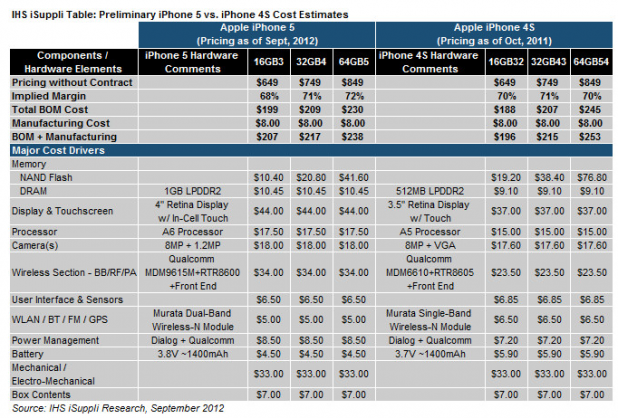[caption id="attachment_4722" align="aligncenter" width="506"]

Apple's iPhone 5 (left) boasts a larger screen and faster processor than the iPhone 4S (right).[/caption] A physical teardown of the
iPhone 5 by IHS iSuppli reveals that Apple has managed to keep its materials and manufacturing costs roughly in line with that of the iPhone 4S, suggesting that the company has managed to keep its supply chain efficient despite the new smartphone’s
next-generation technology and larger screen. When it came time to build the iPhone 5, Apple relied on many of the same component suppliers it used for the iPhone 4S, including Samsung—which provided the crucial A6 processor—and Qualcomm. Murata, Dialog, Texas Instruments, Cirrus Logic, and Skyworks also provided updated parts for the new device. IHS iSuppli theorized that some components, including the NAND flash memory, could come from multiple suppliers. Apple switched out the baseband processor for the iPhone 5, going with Qualcomm’s MDM9615M and RTR8600 parts (which support the LTE air standard) over the iPhone 4S’s Qualcomm MDM6610 and RTR8605 devices. “The support for 4G LTE in the iPhone 5 added a new level of complexity to the radio frequency (RF) front end, so much so that Apple had to create two different models of the iPhone to accommodate their wireless carrier partners,” said Wayne Lam, senior analyst for wireless communications at IHS. “This represents a departure from Apple’s approach of offering only a single model for the iPhone 4S.” The firm estimated the Bill of Materials (BOM) for iPhone 5’s low-end model at $199.00, rising to $207.00 once manufacturing costs are entered into the equation. It tallied the BOM for the 32GB version at $209.00 (or $217 with manufacturing) and the 64GB one at $230.00 (rising slightly to $238 with those manufacturing costs). Compare that to
the BOM for the iPhone 4S, which IHS iSuppli estimated at $188 for the 16GB version (rising to $196 with manufacturing costs added in), $207 for the 32GB version ($215 with manufacturing) and $245 for the 64GB version ($254 with manufacturing). If those estimates align with Apple’s own numbers, then it suggests the company has managed to tailor its supplier contracts and manufacturing chain in such a way that its costs stay relatively level despite each new iPhone’s evolutionary hardware leap. "While most manufacturers make great effort to simplify designs by minimizing the total number of mechanical parts and fasteners in their products, Apple appears to be going in the other direction with the iPhone 5,” Kevin Keller, senior principal analyst of teardown analysis for IHS, wrote in a Sept. 25 statement. “The iPhone 5 incorporates even more mechanical parts than previous iPhone designs, resulting in a very complex assembly. But Apple can do this and still produce the iPhone 5 at such low costs due to its capability to leverage its vast army of low-cost labor.” Moreover, the iPhone 5 will be available in 31 countries by Sept. 28, spreading to 100 by the end of 2012.
According to Reuters, “That would be 30 more than the rollout of the [iPhone 4S] over a similar period, Jeffries analyst Peter Misek calculated.” It’s also further evidence that Apple has managed to work out many of the kinks associated with iPhone manufacture and shipment, something the news agency attributes in large part to CEO Tim Cook, who as Apple’s COO specialized in refining its supply chain. The iPhone 5 managed to sell some 5 million units in its first weekend of release, selling out the company’s initial supply. Ordering off the Apple Website results in estimated ship times of 3-4 weeks, suggesting that, despite the company’s success in keeping its unit costs down, it faces the usual issues with fully meeting demand during a product’s initial launch phase.
 Images: Apple, IHS iSuppli
Images: Apple, IHS iSuppli  Apple's iPhone 5 (left) boasts a larger screen and faster processor than the iPhone 4S (right).[/caption] A physical teardown of the iPhone 5 by IHS iSuppli reveals that Apple has managed to keep its materials and manufacturing costs roughly in line with that of the iPhone 4S, suggesting that the company has managed to keep its supply chain efficient despite the new smartphone’s next-generation technology and larger screen. When it came time to build the iPhone 5, Apple relied on many of the same component suppliers it used for the iPhone 4S, including Samsung—which provided the crucial A6 processor—and Qualcomm. Murata, Dialog, Texas Instruments, Cirrus Logic, and Skyworks also provided updated parts for the new device. IHS iSuppli theorized that some components, including the NAND flash memory, could come from multiple suppliers. Apple switched out the baseband processor for the iPhone 5, going with Qualcomm’s MDM9615M and RTR8600 parts (which support the LTE air standard) over the iPhone 4S’s Qualcomm MDM6610 and RTR8605 devices. “The support for 4G LTE in the iPhone 5 added a new level of complexity to the radio frequency (RF) front end, so much so that Apple had to create two different models of the iPhone to accommodate their wireless carrier partners,” said Wayne Lam, senior analyst for wireless communications at IHS. “This represents a departure from Apple’s approach of offering only a single model for the iPhone 4S.” The firm estimated the Bill of Materials (BOM) for iPhone 5’s low-end model at $199.00, rising to $207.00 once manufacturing costs are entered into the equation. It tallied the BOM for the 32GB version at $209.00 (or $217 with manufacturing) and the 64GB one at $230.00 (rising slightly to $238 with those manufacturing costs). Compare that to the BOM for the iPhone 4S, which IHS iSuppli estimated at $188 for the 16GB version (rising to $196 with manufacturing costs added in), $207 for the 32GB version ($215 with manufacturing) and $245 for the 64GB version ($254 with manufacturing). If those estimates align with Apple’s own numbers, then it suggests the company has managed to tailor its supplier contracts and manufacturing chain in such a way that its costs stay relatively level despite each new iPhone’s evolutionary hardware leap. "While most manufacturers make great effort to simplify designs by minimizing the total number of mechanical parts and fasteners in their products, Apple appears to be going in the other direction with the iPhone 5,” Kevin Keller, senior principal analyst of teardown analysis for IHS, wrote in a Sept. 25 statement. “The iPhone 5 incorporates even more mechanical parts than previous iPhone designs, resulting in a very complex assembly. But Apple can do this and still produce the iPhone 5 at such low costs due to its capability to leverage its vast army of low-cost labor.” Moreover, the iPhone 5 will be available in 31 countries by Sept. 28, spreading to 100 by the end of 2012. According to Reuters, “That would be 30 more than the rollout of the [iPhone 4S] over a similar period, Jeffries analyst Peter Misek calculated.” It’s also further evidence that Apple has managed to work out many of the kinks associated with iPhone manufacture and shipment, something the news agency attributes in large part to CEO Tim Cook, who as Apple’s COO specialized in refining its supply chain. The iPhone 5 managed to sell some 5 million units in its first weekend of release, selling out the company’s initial supply. Ordering off the Apple Website results in estimated ship times of 3-4 weeks, suggesting that, despite the company’s success in keeping its unit costs down, it faces the usual issues with fully meeting demand during a product’s initial launch phase.
Apple's iPhone 5 (left) boasts a larger screen and faster processor than the iPhone 4S (right).[/caption] A physical teardown of the iPhone 5 by IHS iSuppli reveals that Apple has managed to keep its materials and manufacturing costs roughly in line with that of the iPhone 4S, suggesting that the company has managed to keep its supply chain efficient despite the new smartphone’s next-generation technology and larger screen. When it came time to build the iPhone 5, Apple relied on many of the same component suppliers it used for the iPhone 4S, including Samsung—which provided the crucial A6 processor—and Qualcomm. Murata, Dialog, Texas Instruments, Cirrus Logic, and Skyworks also provided updated parts for the new device. IHS iSuppli theorized that some components, including the NAND flash memory, could come from multiple suppliers. Apple switched out the baseband processor for the iPhone 5, going with Qualcomm’s MDM9615M and RTR8600 parts (which support the LTE air standard) over the iPhone 4S’s Qualcomm MDM6610 and RTR8605 devices. “The support for 4G LTE in the iPhone 5 added a new level of complexity to the radio frequency (RF) front end, so much so that Apple had to create two different models of the iPhone to accommodate their wireless carrier partners,” said Wayne Lam, senior analyst for wireless communications at IHS. “This represents a departure from Apple’s approach of offering only a single model for the iPhone 4S.” The firm estimated the Bill of Materials (BOM) for iPhone 5’s low-end model at $199.00, rising to $207.00 once manufacturing costs are entered into the equation. It tallied the BOM for the 32GB version at $209.00 (or $217 with manufacturing) and the 64GB one at $230.00 (rising slightly to $238 with those manufacturing costs). Compare that to the BOM for the iPhone 4S, which IHS iSuppli estimated at $188 for the 16GB version (rising to $196 with manufacturing costs added in), $207 for the 32GB version ($215 with manufacturing) and $245 for the 64GB version ($254 with manufacturing). If those estimates align with Apple’s own numbers, then it suggests the company has managed to tailor its supplier contracts and manufacturing chain in such a way that its costs stay relatively level despite each new iPhone’s evolutionary hardware leap. "While most manufacturers make great effort to simplify designs by minimizing the total number of mechanical parts and fasteners in their products, Apple appears to be going in the other direction with the iPhone 5,” Kevin Keller, senior principal analyst of teardown analysis for IHS, wrote in a Sept. 25 statement. “The iPhone 5 incorporates even more mechanical parts than previous iPhone designs, resulting in a very complex assembly. But Apple can do this and still produce the iPhone 5 at such low costs due to its capability to leverage its vast army of low-cost labor.” Moreover, the iPhone 5 will be available in 31 countries by Sept. 28, spreading to 100 by the end of 2012. According to Reuters, “That would be 30 more than the rollout of the [iPhone 4S] over a similar period, Jeffries analyst Peter Misek calculated.” It’s also further evidence that Apple has managed to work out many of the kinks associated with iPhone manufacture and shipment, something the news agency attributes in large part to CEO Tim Cook, who as Apple’s COO specialized in refining its supply chain. The iPhone 5 managed to sell some 5 million units in its first weekend of release, selling out the company’s initial supply. Ordering off the Apple Website results in estimated ship times of 3-4 weeks, suggesting that, despite the company’s success in keeping its unit costs down, it faces the usual issues with fully meeting demand during a product’s initial launch phase.  Images: Apple, IHS iSuppli
Images: Apple, IHS iSuppli 
